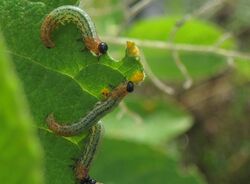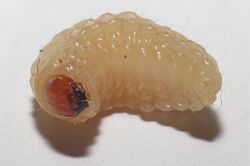Biology:Eruciform


Eruciform (literally: "caterpillar-shaped") is the entomological term describing a certain class of shapes of insect larvae.
Origin and application
The word eruciform literally means "caterpillar-shaped" (from Latin "eruca", a caterpillar — confusingly, in Latin "Eruca" also was used as the name for a rape-like plant, but that has no clear connection to the current context).[1]
The term encompasses many variations in shape. Some larvae, for example, are in fact shaped like certain other, straight, eruciform larvae, except that they are curved into a C-shape. These are called "scarabaeiform" because it is the typical form of the larvae of the Scarabaeidae—the scarab beetles and their relatives. In contrast, larvae of the Curculionidae — the weevils — are also called "apodous eruciform", (literally meaning legless caterpillar-shaped; unlike scarab larvae, they do not have legs). This seems rather inconsistent, because commonly weevil larvae are almost as C-shaped as scarab larvae.[2]
Variations and implications
Some larvae, such as those of most beetles in the family Chrysomelidae, are described as eruciform, although they are short, have swollen abdomens, and have no true "prolegs" such as caterpillars have. Typically they walk freely on leaves and similar surfaces, using the "true" six legs on the three thoracic segments just behind the head. The abdomen is carried behind as a more or less swollen, hump-backed rear end.
In contrast, larvae of the Cerambycidae (Longhorn beetles) are generally straight and could fairly be described as "apodous eruciform". They live in tunnels, typically in wood, where a distended abdomen would be a liability and legs are not the only option for locomotion. Instead of using legs Cerambycid larvae press fleshy bulges against the walls of their tunnels.[3]
Arguably the most typically eruciform larvae, prolegs and all, are to be found among the butterflies and moths (Lepidoptera), caddis larvae (Trichoptera), and sawflies (Symphyta)[2]
References
- ↑ Jaeger, Edmund C. (1959). A source-book of biological names and terms. Springfield, Ill: Thomas. ISBN 0-398-06179-3. https://archive.org/details/sourcebookofbiol0000jaeg.
- ↑ 2.0 2.1 Imms' General Textbook of Entomology: Volume 1: Structure, Physiology and Development Volume 2: Classification and Biology. Berlin: Springer. 1977. ISBN 0-412-61390-5.
- ↑ Bannister, Anthony; Skaife, Sally; Ledger, John (1979). African insect life. Feltham: Country Life Books. ISBN 0-600-34920-9.
External links
 |



